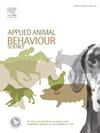Behavioral effects of floor pens as environmental enrichment for laboratory rabbits (Oryctolagus cuniculus)
IF 2.2
2区 农林科学
Q1 AGRICULTURE, DAIRY & ANIMAL SCIENCE
引用次数: 0
Abstract
Laboratory animals are indispensable for science, particularly in biomedical research. Their welfare must meet their physical, social and physiological needs. Ethological evaluations are crucial for identifying and correcting abnormal behaviors caused by captivity, often through tools like environmental enrichment (EE). This study evaluated the behavioral effects of implementing floor pens as EE for individually caged laboratory rabbits. A single observer analyzed the behavior of 24 male adult rabbits inside the cages (48 ×80 x 60 cm) before the EE application through all-sample observations over two months. After, the test group (n = 15) was introduced to large floor pens (120 ×180 cm; no ceiling) once a week for two months, with 60 s all-sample observations every 10 minutes. The control group (n = 9) was not introduced to the EE. After this period, all animals were observed once again inside the cages, in order to compare behavioral frequencies before and after the EE application using appropriate statistical tests. The test group showed increased inactivity (31.1 vs. 55.4 %; Student's t-test, t = - 9.34, p < 0.001) and a significant decrease in negative behaviors (13.5 vs. <5 %; Wilcoxon test, V = 119, p < 0.001) after the EE application. Both behavioral categories frequencies aligned more closely to values reported in other related studies. Inside the floor pens, rabbits expressed locomotory, exploratory and positive behaviors for a great portion of time (more than 80 % of total time). These findings highlight the effectiveness of implementing floor pens as EE in reducing negative behaviors, increasing daytime inactivity, and promoting exploration and positive welfare of laboratory rabbits.
落地式围栏对小兔环境富集行为的影响
实验动物对科学,特别是生物医学研究是不可或缺的。他们的福利必须满足他们的生理、社会和生理需要。动物行为学评估对于识别和纠正圈养引起的异常行为至关重要,通常通过环境富集(EE)等工具进行。本研究评估了地板围栏作为情感表达对单独笼养实验家兔的行为影响。一名观察员通过两个多月的全样本观察,分析了24只雄性成年兔在EE应用前在笼子内(48 ×80 x 60 cm)的行为。之后,实验组(n = 15)被引入大落地笔(120 ×180 cm;(无上限)每周一次,持续两个月,每10 分钟进行60次 全样本观察。对照组(n = 9)不引入EE。在这段时间之后,所有的动物再次在笼子里观察,以便使用适当的统计测试来比较EE应用前后的行为频率。试验组显示不活动增加(31.1比55.4% %;学生t检验,t = - 9.34,p <; 0.001),负性行为显著减少(13.5 vs. <5 %;应用EE后的Wilcoxon检验,V = 119, p <; 0.001)。这两种行为类别的频率与其他相关研究报告的值更接近。在地板围栏内,兔子在很大程度上表现出运动、探索和积极的行为(超过80% %的总时间)。这些发现强调了将地板围栏作为情感表达在减少实验兔的消极行为、增加白天不活动、促进探索和积极福利方面的有效性。
本文章由计算机程序翻译,如有差异,请以英文原文为准。
求助全文
约1分钟内获得全文
求助全文
来源期刊

Applied Animal Behaviour Science
农林科学-行为科学
CiteScore
4.40
自引率
21.70%
发文量
191
审稿时长
18.1 weeks
期刊介绍:
This journal publishes relevant information on the behaviour of domesticated and utilized animals.
Topics covered include:
-Behaviour of farm, zoo and laboratory animals in relation to animal management and welfare
-Behaviour of companion animals in relation to behavioural problems, for example, in relation to the training of dogs for different purposes, in relation to behavioural problems
-Studies of the behaviour of wild animals when these studies are relevant from an applied perspective, for example in relation to wildlife management, pest management or nature conservation
-Methodological studies within relevant fields
The principal subjects are farm, companion and laboratory animals, including, of course, poultry. The journal also deals with the following animal subjects:
-Those involved in any farming system, e.g. deer, rabbits and fur-bearing animals
-Those in ANY form of confinement, e.g. zoos, safari parks and other forms of display
-Feral animals, and any animal species which impinge on farming operations, e.g. as causes of loss or damage
-Species used for hunting, recreation etc. may also be considered as acceptable subjects in some instances
-Laboratory animals, if the material relates to their behavioural requirements
 求助内容:
求助内容: 应助结果提醒方式:
应助结果提醒方式:


